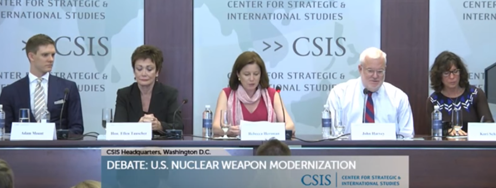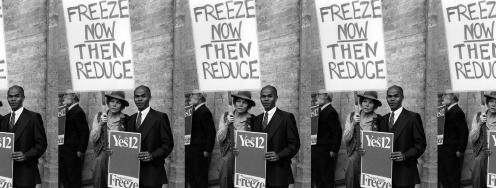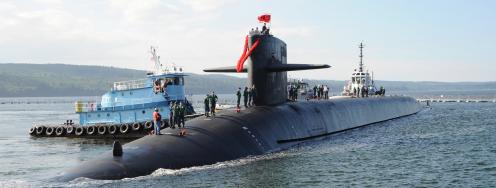Sid Drell on the Logic of Nuclear Zero
Is it illogical to think of a world without nuclear weapons? Must we accept the world as it is, with nuclear weapons, as many in the high priesthood of strategic policy insist? That was a broad reaction to the effort to get rid of them that Ronald Reagan and Mikhail Gorbachev made at the Reykjavik Summit 26 years ago in what George Shultz has called “the highest stakes poker game ever played.” And I still hear it frequently today.
Accepting a world with nuclear weapons as inescapable means nothing less than also accepting it to be inevitable that, sooner or later, there will be a nuclear explosion somewhere – deliberate or otherwise. Things happen; there are errors in systems involving humans, like the 6 nuclear armed cruise missiles that were mistakenly loaded on a B-52 enroute from North Dakota to Louisiana in 2007 without being missed for 36 hours. Just consider the consequences, long term as well as immediate, of a nuclear bomb exploding in Washington, Moscow, Beijing, or wherever. They will be so appalling that people everywhere will demand that governments do something about it. Wouldn’t it be wise to do something before rather than after such an explosion?
What prevents us from attaining a goal of a world without nuclear weapons? Why is it dismissed as illogical?
Since the end of the Cold War two decades ago, we have shown that it is possible to make substantial progress in reducing nuclear arsenals; U.S. and Russia are down to a fraction of their peak level of about 70 thousand warheads at the time of Reykjavik. In the New START treaty of 2011 we have negotiated intrusive and cooperative on-site inspections, including actually counting the numbers of deployed warheads, as well as all delivery vehicles. This was unthinkable during the Cold War. Thus far we are implementing them without a hitch.
But the numbers of existing nuclear weapons are still very large – in the thousands. Their absurdly large number is a good example of what to me is truly illogical. We are still caught in the Cold War trap of nuclear deterrence more than two decades after the demise of the Soviet Union. But what are they deterring now?
They are credited with deterring a nuclear holocaust, or worse, during the Cold War but what else did they deter? Not the Korean War, not the squashing of the Hungarian and Czech uprisings. We have recently marked the 50th anniversary of the Cuban missile crisis, but there were other close calls during the Cold War.
In today’s world, with the spread of nuclear technology and know-how, the prospects of these weapons being acquired, and even being used, by dangerous proliferants or suicidal terrorists are growing, at the same time as their value to our security is decreasing. In fact I find it very difficult to think of a scenario in which the use of nuclear weapons would be appropriate or effective in dissuading their being used on suicidal missions. Our conventional forces are appropriate and more than adequate against a threat to regional peace and security by hostile states.
It is the growing dangers of remaining in the nuclear deterrence trap with excessively large nuclear arsenals that motivated my four distinguished colleagues, George Shultz, Sam Nunn, Henry Kissinger, Bill Perry, and myself, to undertake the challenge to demonstrate that there exists a practical path to creating the conditions for a world without nuclear weapons, and to help pave that path. We are proud and honored to receive the Federation of American Scientists Public Service Medal for 2012 in recognition of this work. In accepting this award, I assure you that our commitment to achieving this goal will continue unabated.
We believe that each of the steps we propose for a start on this journey to a world without nuclear weapons is practical, given the political will, and will, on their own, contribute to reducing the dangers in today’s world. They would have to start, step by step, apace with the Russians, but necessarily joined by the commitment by other nuclear powers. Subsequently they must gain a firm commitment from a broad coalition of countries who share this vision of a world without nuclear weapons, and who are convinced that the nuclear powers are genuinely on board.
We recognize this to be an enormous challenge. It won’t be a return to the world as it was pre- Hiroshima and Nagasaki. For it will require developing technology establishing an unprecedented degree of cooperation and transparency to provide confidence against the possibility of the covert reconstitution of a nuclear arsenal. A daunting task to be sure, but given the dangers in an alternative world with broad nuclear proliferation, it is an urgent and compelling challenge to tackle.
When the going gets hard, and the challenge just too difficult, it is important not to forget how far we have come two decades after the end of the Cold War. Many, including some of us in the technical community, were skeptical, even dismissive, in our initial reaction to President Reagan’s insistence on intrusive onsite cooperative inspections in negotiating the INF Treaty with Gorbachev in 1987. He succeeded, and those provisions that led to the elimination of all the intermediate range missiles in Europe are now the heart and soul of New START.
Here at FAS, the first organization organized after Hiroshima and Nagasaki to address the grave new challenge to civilization posed by nuclear weapons, I call on my colleagues in the science and technology community to meet this challenge, and work to disarm the skeptics and cynics who dismiss zero as an unrealistic unachievable goal.
Recall the wisdom of Austrian philosopher Arthur Schopenhauer who said: “All truth passes through three stages:
- First, it is ridiculed;
- Second, it is violently opposed;
- Third, it is accepted as self-evident.
Remarks by Sid Drell in Accepting the Federation of American Scientists 2012 Public Service Award to George P. Shultz, Bill Perry, Sam Nunn, Henry A. Kissinger, and Sidney D. Drell on November 9, 2012.



